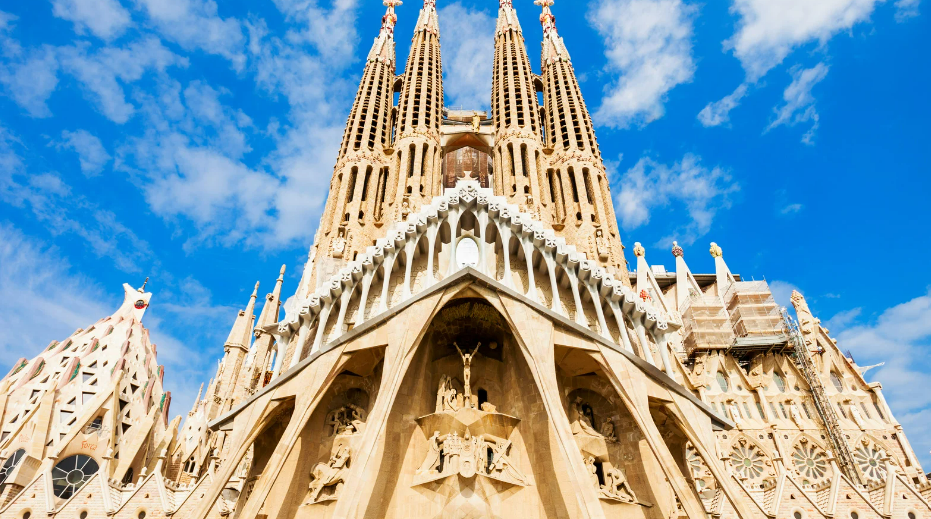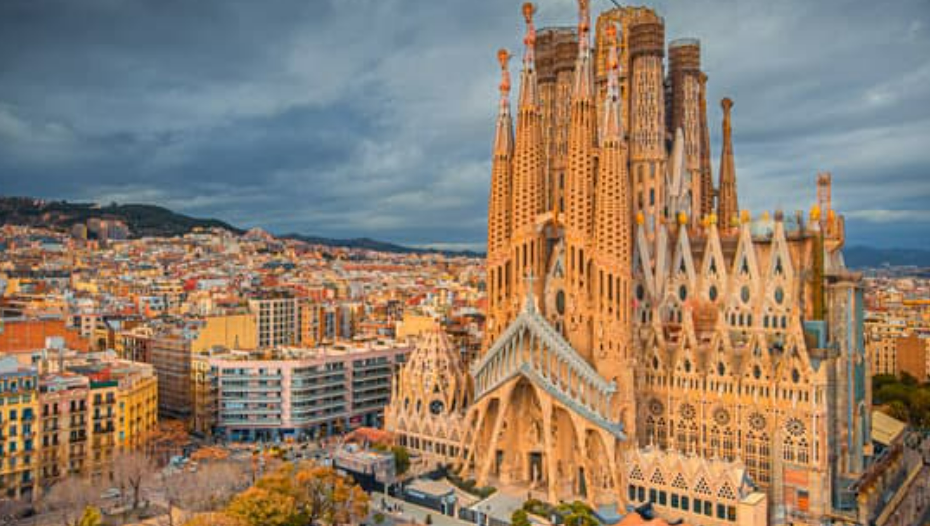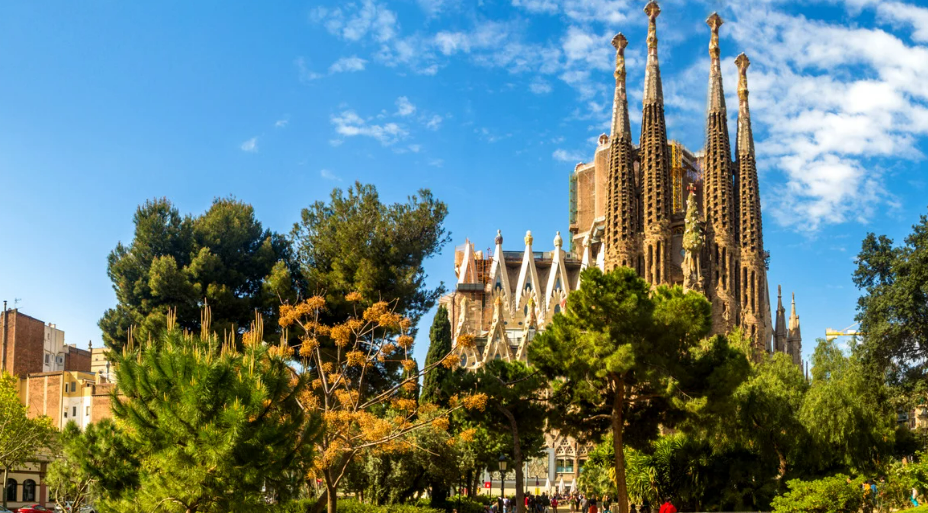Why Visit Sagrada Familia: A Comprehensive Guide

The Sagrada Familia, an iconic basilica in Barcelona, Spain, is a masterpiece of modernist architecture and a testament to the genius of its creator, Antoni Gaudí. This awe-inspiring structure has been under construction since 1882 and continues to captivate visitors with its intricate designs, towering spires, and profound symbolism. Whether you’re an architecture enthusiast, a history buff, or a spiritual seeker, the Sagrada Familia offers an unforgettable experience.
Architectural Marvel
The Sagrada Familia stands as one of the most extraordinary examples of modernist architecture in the world. Antoni Gaudí, the mastermind behind this grand basilica, envisioned a structure that would combine Gothic and Art Nouveau forms, creating a unique and highly symbolic design.
Exterior
The exterior of the Sagrada Familia is adorned with elaborate façades, each telling a different story from the Bible. The Nativity Façade, completed during Gaudí’s lifetime, celebrates the birth of Jesus and is characterized by its ornate and joyful sculptures. In contrast, the Passion Façade, designed by Josep Maria Subirachs, depicts the suffering and crucifixion of Christ with stark, angular lines and dramatic shadows. The Glory Façade, still under construction, will represent the ascension to heaven and the eternal glory of Jesus.
The basilica’s eighteen spires, which are still being built, will ultimately represent the Twelve Apostles, the Virgin Mary, the four Evangelists, and Jesus Christ, with the tallest spire dedicated to Jesus rising to a height of 172.5 meters, making it the tallest religious building in Europe.
Interior
Stepping inside the Sagrada Familia is like entering a surreal forest of stone and light. Gaudí’s innovative use of light and color transforms the interior into a breathtaking space. The columns, designed to resemble trees, branch out as they rise, supporting the intricate vaults above. The stained glass windows, crafted by artist Joan Vila-Grau, bathe the interior in a kaleidoscope of colors, creating a serene and contemplative atmosphere.
Gaudí’s attention to detail extends to every aspect of the basilica’s design, from the symbolic carvings and sculptures to the geometric patterns that reflect his fascination with nature and mathematics. The interplay of light, color, and form creates a sense of harmony and transcendence, making a visit to the Sagrada Familia a deeply moving experience.
Historical Significance
The construction of the Sagrada Familia began in 1882 under architect Francisco de Paula del Villar. However, it was not until Antoni Gaudí took over the project in 1883 that it transformed into the iconic structure we see today. Gaudí devoted the last 15 years of his life entirely to the Sagrada Familia, living on-site and pouring his heart and soul into its design.
Despite Gaudí’s death in 1926, work on the basilica continued, guided by his detailed plans and models. The Spanish Civil War in the 1930s caused significant damage to the project,
but the restoration and construction efforts resumed with renewed vigor in the 1950s. Today, the Sagrada Familia is a UNESCO World Heritage Site and one of the most visited monuments in Spain, drawing millions of visitors from around the globe each year.
Symbolism and Spirituality
The Sagrada Familia is not just an architectural marvel; it is also rich in symbolism and spiritual meaning. Gaudí designed every element of the basilica to convey Christian teachings and the natural world’s beauty.
The Façades
- Nativity Façade: This façade celebrates the birth of Jesus and is full of intricate details depicting scenes from Christ’s early life. It represents hope, joy, and the promise of salvation.
- Passion Façade: In stark contrast, the Passion Façade is somber and austere, illustrating the suffering and sacrifice of Jesus. Its angular and minimalist design evokes a sense of pain and contemplation.
- Glory Façade: Once completed, this façade will be the most significant and will symbolize Christ’s eternal glory. It will include representations of the Last Judgment, Heaven, and Hell.
The Interior
Inside the basilica, Gaudí’s use of light and geometry creates a space that feels both otherworldly and deeply spiritual. The columns resemble trees, forming a forest canopy that leads the eye upward toward the heavens. The play of light through the stained glass windows changes throughout the day, symbolizing the passage of time and the eternal nature of God.
Gaudí intended the Sagrada Familia to be a “bible in stone,” where visitors could experience the story of Christianity through art and architecture. The basilica’s design encourages reflection, meditation, and a profound sense of awe.
Visiting the Sagrada Familia: Tips and Practical Information
To fully appreciate the grandeur and significance of the Sagrada Familia, planning your visit carefully is essential. Here are some tips and practical information to help you maximize your experience.
Plan Ahead
- Purchase Tickets in Advance: The Sagrada Familia is one of Barcelona’s most popular attractions, and tickets can sell out quickly, especially during peak tourist seasons. It is highly recommended to buy tickets online in advance to secure your preferred time slot and avoid long queues.
- Choose the Right Ticket: There are several types of tickets available, ranging from basic entry to guided tours and access to the towers. Decide what level of access and information you want before purchasing your ticket.
Best Time to Visit
- Early Morning or Late Afternoon: To avoid the crowds and enjoy a more peaceful experience, visit the Sagrada Familia early in the morning or late in the afternoon. These times also offer the best lighting conditions for photography, with the sunlight streaming through the stained glass windows.
Explore the Surroundings
- Park Güell: Another of Gaudí’s masterpieces, Park Güell, is located a short distance from the Sagrada Familia. Combining these two attractions in one day can provide a deeper understanding of Gaudí’s vision and genius.
- Hospital de Sant Pau: Located nearby, this modernist complex designed by Lluís Domènech i Montaner is a lesser-known gem and a UNESCO World Heritage Site. It offers a fascinating insight into early 20th-century architecture and healthcare.
Take a Guided Tour
- Learn from Experts: A guided tour can enrich your visit by providing detailed explanations of the basilica’s history, symbolism, and architectural features. Knowledgeable guides can offer insights you might miss on your own, making the experience more engaging and informative.
Accessibility
- Mobility Access: The Sagrada Familia is wheelchair accessible, with ramps and elevators available. Inform staff if you require assistance, and they will gladly help.
- Audio Guides: For visitors who prefer a self-guided experience, audio guides are available in multiple languages. These guides provide in-depth information about the basilica at your own pace.
Photography Tips
- Best Spots: Some of the best photography spots include the Nativity Façade in the morning and the Passion Façade in the late afternoon. Inside, the light filtering through the stained glass windows creates stunning opportunities for capturing the basilica’s unique ambiance.
- Respect the Space: Remember that the Sagrada Familia is a place of worship. Be respectful of others, and avoid using flash or loud camera settings.
Tickets and Pricing
- Basic Entry: Tickets for basic entry to the basilica start at around €26 for adults. This ticket includes access to the main nave, the museum, and the schools designed by Gaudí.
- Guided Tours: For a more in-depth experience, consider a guided tour. Prices start at around €30 per person, with various options available, including small group tours and private tours.
- Tower Access: To enjoy panoramic views of Barcelona, you can add tower access to your ticket. Prices for this option start at around €36. Note that tower access involves climbing stairs, so it may not be suitable for visitors with mobility issues.
- Discounts: Reduced rates are available for students, seniors, and children. Check the official Sagrada Familia website or Sagrada Tickets for current prices and discount eligibility.
Conclusion
The Sagrada Familia is a testament to human creativity, devotion, and perseverance. Visiting this extraordinary basilica offers a profound experience that transcends architecture, inviting visitors to explore the depths of faith, art, and history. By planning your visit, understanding the significance of its design, and appreciating the intricate details that Gaudí envisioned, you can make the most of your journey to this unparalleled symbol of Barcelona. Whether you are moved by its spiritual resonance, captivated by its architectural brilliance, or simply awed by its grandeur, the Sagrada Familia promises to be an unforgettable highlight of your travels.
-
Personal Finance1 year ago
How Do I Find My UCAS ID Number?
-
Success6 years ago
Consistency: The Key Ingredient to Success
-
Personal Finance1 year ago
What Does Conditionally Approved Mean For An Apartment?
-
Motivation3 years ago
How To Become a More Organized Person?
-
Others5 years ago
Work Health and Safety: 8 Reasons to Maintain a Clutter-free Office
-
Entrepreneurs4 years ago
Why Diversity is Key in Business Marketing
-
HK Pools1 year ago
The HK Pools Forum Comunity Jos Markotop 2D Warna Kuning – A Great Way to Stay Connected
-
Sport2 years ago
What Makes Soccer Betting So Great?





























